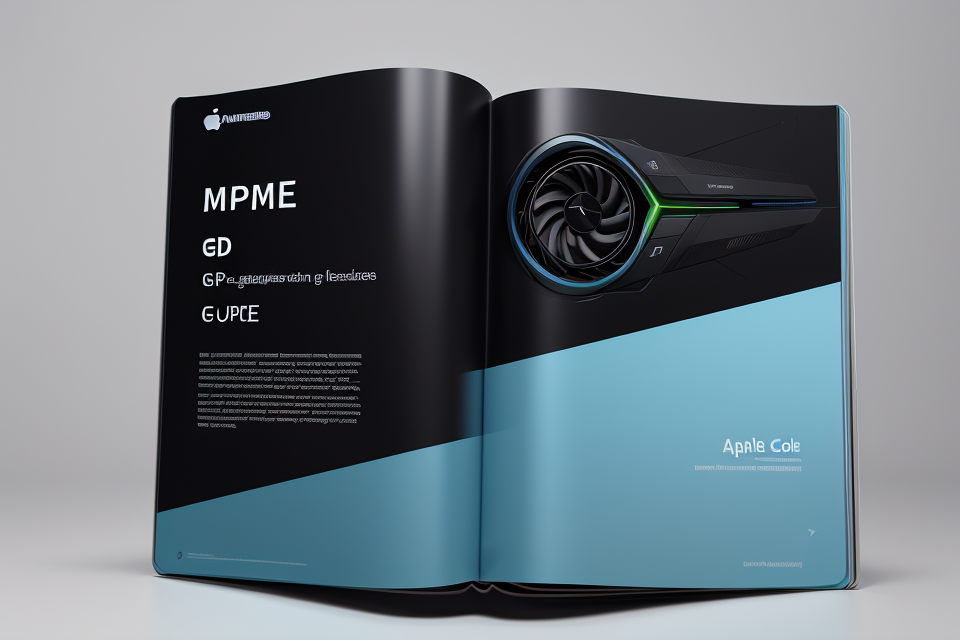
When it comes to selecting the perfect Graphics Processing Unit (GPU) for your gaming or professional needs, it can be overwhelming to navigate through the technical specifications and jargon. But fear not, as we are here to help you make sense of it all. Among the many specifications, the most important one for a GPU is its CUDA cores, also known as Streaming Multiprocessors (SMs). CUDA cores are the heart of a GPU, responsible for performing the majority of the calculations required for rendering images and animations. They determine the speed and efficiency of the GPU, making them the key factor in determining the overall performance of your system. So, when shopping for a new GPU, keep an eye on the number of CUDA cores and remember that more is always better.
The most important specification for a GPU (Graphics Processing Unit) is its performance, which is typically measured in FLOPs (Floating Point Operations per Second) or CUDA cores. This indicates how quickly the GPU can process and render graphics, which is crucial for tasks such as gaming, video editing, and 3D rendering. Additionally, memory capacity and bandwidth are also important specifications to consider, as they determine the amount of data the GPU can store and transfer at any given time. The type and number of connectors on the GPU can also be important depending on the specific use case, such as the number of display outputs for gaming or the support for high-speed data transfer for professional applications. Ultimately, the most important specification for a GPU will depend on the specific requirements of the user’s application or task.
Understanding GPU Specifications
Functions of a GPU
A Graphics Processing Unit (GPU) is a specialized processor designed to handle the rendering of graphics and visual effects in electronic devices such as computers, gaming consoles, and mobile devices. The functions of a GPU include:
- Rendering graphics: A GPU is responsible for rendering complex graphics and visual effects in real-time. This involves processing large amounts of data to create images and animations that are displayed on the screen. The GPU is designed to handle this task efficiently, using specialized hardware and software algorithms to speed up the rendering process.
- Handling complex computations: In addition to rendering graphics, a GPU is also capable of handling complex computations that are required for tasks such as scientific simulations, cryptography, and artificial intelligence. These computations often involve large amounts of data and require a high degree of processing power. The GPU is designed to handle these tasks with ease, using its specialized hardware and software to accelerate the computation process.
- Processing large datasets: A GPU is also capable of processing large datasets that are used in applications such as machine learning, deep learning, and big data analytics. These datasets can be incredibly large and require a high degree of processing power to analyze and make sense of the data. The GPU is designed to handle this task efficiently, using its specialized hardware and software to accelerate the processing of large datasets.
Overall, the functions of a GPU are critical to the performance of electronic devices that rely on graphics and visual effects. By handling the rendering of graphics, complex computations, and processing of large datasets, a GPU helps to ensure that these devices operate smoothly and efficiently.
Key Specifications of a GPU
When it comes to choosing the right GPU for your needs, it’s important to understand the key specifications that can impact performance. Here are some of the most important specifications to consider:
CUDA cores
CUDA cores are the processing units within a GPU that are responsible for executing calculations and rendering graphics. The number of CUDA cores can have a significant impact on the overall performance of the GPU, with more cores generally resulting in faster rendering times.
VRAM
VRAM, or video memory, is used to store the data that is being rendered on the GPU. The amount of VRAM available can impact the amount of data that can be stored at once, which can affect performance in applications that require a lot of memory, such as video editing or gaming.
Base clock speed
The base clock speed of a GPU refers to the rate at which the processor can execute instructions. A higher base clock speed generally means that the GPU can process more instructions per second, which can translate into faster performance.
Boost clock speed
The boost clock speed is the maximum clock speed that a GPU can reach under certain conditions, such as when the GPU is under load. A higher boost clock speed can result in faster performance, particularly in applications that require a lot of processing power.
Memory bandwidth
Memory bandwidth refers to the rate at which data can be transferred between the GPU and memory. A higher memory bandwidth can result in faster data transfer rates, which can impact performance in applications that require a lot of data to be processed quickly.
Thermal design power (TDP)
The thermal design power of a GPU refers to the maximum amount of heat that the GPU can dissipate without overheating. A higher TDP can result in more efficient cooling, which can help prevent the GPU from overheating during prolonged use. However, it’s important to note that a higher TDP can also result in higher power consumption, which may impact the overall efficiency of the system.
The Most Important Spec for a GPU: CUDA Cores
What are CUDA cores?
CUDA (Compute Unified Device Architecture) is a parallel computing platform and programming model developed by NVIDIA. It allows developers to leverage the power of GPUs to accelerate computations and improve the performance of applications. CUDA cores are the processing units within a GPU that perform calculations and execute instructions. They are the primary building blocks of a GPU and are responsible for the massive parallelism that GPUs are known for.
CUDA cores are designed to perform multiple mathematical operations simultaneously, allowing GPUs to handle large amounts of data quickly and efficiently. Each CUDA core can perform a single instruction per clock cycle, and the more cores a GPU has, the more instructions it can process in parallel. This means that a GPU with more CUDA cores can perform more calculations per second, resulting in faster performance and smoother graphics.
CUDA cores are also responsible for the performance of machine learning and deep learning applications. These applications require large amounts of parallel processing power, and CUDA cores are designed to provide just that. They can perform complex calculations and simulations much faster than traditional CPUs, making them ideal for tasks such as image recognition, natural language processing, and video analytics.
In summary, CUDA cores are the heart of a GPU, responsible for its performance and capabilities. The number of CUDA cores in a GPU is one of the most important specifications to consider when choosing a graphics card, as it directly affects the card’s ability to handle demanding applications and workloads.
Why are CUDA cores the most important spec for a GPU?
- CUDA cores are the primary driver of parallel computation performance: The number of CUDA cores directly affects the GPU’s ability to perform parallel computations, which is a crucial aspect of its overall performance.
- Higher number of CUDA cores means more efficient parallel processing: As the number of CUDA cores increases, the GPU becomes more efficient at processing multiple tasks simultaneously. This is especially important in applications that require heavy parallel processing, such as gaming, rendering, and AI.
- CUDA cores have a direct impact on the GPU’s performance in gaming, rendering, and AI applications: These applications rely heavily on the GPU’s ability to perform parallel computations, and the number of CUDA cores directly affects the GPU’s performance in these areas. As a result, a higher number of CUDA cores generally leads to better performance in these applications.
Other Important GPU Specs
VRAM
Explanation of VRAM
Video Random Access Memory (VRAM) is a type of memory that is dedicated to storing data during the process of graphic rendering. It is an essential component of a GPU, as it enables the GPU to store and manipulate graphical data while it is being processed. VRAM is different from the system RAM, which is used for general computing purposes.
Importance of VRAM
The amount of VRAM available on a GPU is a critical specification, as it determines the type and complexity of graphics that can be rendered. More VRAM allows for more complex graphics and larger scenes, as it provides the GPU with additional memory to store and manipulate graphical data. This is particularly relevant for applications such as gaming, video editing, and 3D modeling, where the GPU needs to process large amounts of graphical data in real-time.
VRAM vs. System RAM
While VRAM and system RAM are both types of memory, they serve different purposes. System RAM is used for general computing purposes, such as running applications and storing data. VRAM, on the other hand, is specifically designed for graphic rendering and does not affect the performance of other computing tasks. It is important to note that VRAM is not interchangeable with system RAM, and the amount of VRAM available on a GPU is not directly related to the amount of system RAM available on a computer.
Base and Boost Clock Speeds
The base clock speed, also known as the standard clock speed, is the rate at which the GPU operates under normal conditions. It is typically measured in GHz (gigahertz) and represents the number of cycles per second that the GPU’s transistors can perform.
The boost clock speed, on the other hand, is the higher rate at which the GPU can temporarily reach for more demanding tasks. It is also measured in GHz and represents the maximum number of cycles per second that the GPU can perform.
Importance of Higher Clock Speeds
Higher clock speeds lead to faster performance, as the GPU can process more instructions per second. This means that a GPU with a higher base and boost clock speed will be able to handle more demanding tasks and provide smoother performance during gaming or other graphics-intensive applications.
However, it is important to note that clock speeds are just one aspect of a GPU’s performance, and other factors such as memory bandwidth, number of cores, and power consumption also play a significant role in determining a GPU’s overall performance.
Overall, while base and boost clock speeds are important specifications to consider when choosing a GPU, they should not be the only factor taken into account. It is important to consider all relevant specifications and performance metrics to make an informed decision when selecting a GPU for your needs.
Memory Bandwidth
- Measuring Data Transfer Rate: Memory bandwidth is a measure of the rate at which the GPU transfers data between its memory and the rest of the system. It is typically expressed in megabytes per second (MB/s) or gigabytes per second (GB/s).
- Impact on Performance: Higher memory bandwidth translates to smoother frame rates and faster data processing. It is a critical factor for graphics-intensive applications such as gaming, video editing, and 3D modeling.
- Factors Affecting Memory Bandwidth: The memory bandwidth of a GPU is influenced by several factors, including the type and speed of the memory, the number of memory channels, and the interface between the GPU and the memory.
- Comparing Memory Bandwidth Across GPUs: When comparing GPUs, it is important to consider the memory bandwidth in relation to the type of workload the GPU will be handling. For instance, a high-end gaming GPU may require more memory bandwidth than a professional GPU designed for video editing or 3D modeling.
- Importance for Future-Proofing: Memory bandwidth is also an important consideration when future-proofing a system. As applications become more demanding, a GPU with higher memory bandwidth is more likely to be able to handle the increased workload.
Thermal Design Power (TDP)
The Thermal Design Power (TDP) of a GPU is a critical specification that determines the maximum amount of power the GPU can consume and dissipate as heat. It is a crucial metric for evaluating the cooling requirements of a GPU and ensuring stable operation. A higher TDP typically indicates better cooling requirements and potential for higher performance.
TDP is an important factor to consider when selecting a GPU, as it directly affects the cooling solution required for the GPU. A higher TDP requires more advanced cooling mechanisms, such as larger heatsinks or more powerful fans, to dissipate the increased amount of heat generated by the GPU. This is crucial for preventing overheating and ensuring stable operation, as overheating can lead to decreased performance, system crashes, and even permanent damage to the GPU.
It is important to note that TDP is not the only factor that affects a GPU’s thermal performance. Other factors, such as the size and quality of the heatsink, the efficiency of the cooling solution, and the ambient temperature of the system, also play a significant role in determining the GPU’s thermal performance.
When selecting a GPU, it is important to consider the TDP of the GPU and ensure that the cooling solution chosen is capable of dissipating the heat generated by the GPU. This will help ensure stable operation and optimal performance of the GPU.
Factors Affecting GPU Performance
Power Supply Unit (PSU)
The Power Supply Unit (PSU) is a critical component in any computer system, as it provides the necessary power to all components, including the Graphics Processing Unit (GPU). Adequate PSU wattage is crucial for stable operation and optimal performance of the GPU. The recommended wattage depends on the GPU’s Thermal Design Power (TDP) and other components in the system.
The TDP is the maximum amount of power that the GPU can consume during operation, and it is essential to have a PSU that can provide enough power to handle this. If the PSU is not powerful enough, it may not be able to provide the necessary current and voltage to the GPU, leading to instability and potential damage to the component.
When selecting a PSU for a GPU, it is important to consider the wattage, efficiency, and form factor. A higher wattage PSU will generally provide more stable power and support higher TDPs. Efficiency, measured in percentage, indicates how well the PSU converts the input power into usable power. A higher efficiency rating means that less power is lost as heat, resulting in a more efficient system. The form factor refers to the physical size of the PSU and should be compatible with the computer case.
Additionally, it is crucial to ensure that the PSU has enough connectors to power all components in the system, including the GPU. A PSU with sufficient connectors, such as 6-pin and 8-pin PCIe connectors, will provide the necessary power to the GPU, allowing it to operate at its full potential.
In summary, the Power Supply Unit (PSU) is a vital component in any computer system, particularly for GPU performance. It is essential to have a PSU with adequate wattage, efficiency, and connectors to ensure stable operation and optimal performance of the GPU.
Cooling
Cooling is a critical factor that affects the performance and longevity of a GPU. As a GPU operates, it generates heat that must be dissipated to prevent overheating and thermal throttling. Thermal throttling occurs when the GPU’s temperature exceeds a certain threshold, causing the GPU to reduce its clock speed and performance to prevent damage.
To maintain optimal performance and prevent thermal throttling, it is essential to ensure that the GPU is adequately cooled. The following are some factors to consider when it comes to cooling a GPU:
- Adequate cooling: The GPU should be equipped with a sufficient cooling solution to dissipate the heat generated during operation. This can include a factory-installed heatsink and fan or an aftermarket solution such as custom water cooling or larger air coolers.
- Fan design and quality: The fan’s design and quality also impact the GPU’s temperature and noise levels. A high-quality fan with a larger diameter and wider blade surface area can move more air and generate less noise than a smaller, lower-quality fan. Additionally, a fan with a wider blade surface area can increase airflow and help keep the GPU cooler.
- Fan speed and control: The fan’s speed and control also play a significant role in cooling the GPU. Some GPUs may come with a factory-installed fan speed control, while others may require an aftermarket solution such as a fan controller or software to control the fan’s speed. It is essential to monitor the GPU’s temperature and adjust the fan speed accordingly to prevent overheating and thermal throttling.
In summary, adequate cooling is necessary to maintain optimal performance and prevent overheating and thermal throttling. The fan’s design, quality, speed, and control also impact the GPU’s temperature and noise levels. It is essential to choose a suitable cooling solution and monitor the GPU’s temperature to ensure that it operates within safe parameters.
FAQs
1. What is the most important spec for a GPU?
The most important spec for a GPU (Graphics Processing Unit) is its performance, which is measured in floating point operations per second (FLOPS) or more commonly, in CUDA cores (for NVIDIA GPUs) or Stream Processors (for AMD GPUs). This performance determines how quickly the GPU can process and render graphics, and therefore, the overall gaming or graphics performance of the system.
2. What are FLOPS and how do they relate to GPU performance?
FLOPS (floating point operations per second) is a measure of the computational power of a GPU, and it indicates how many floating point operations the GPU can perform in one second. FLOPS is often used as a benchmark for measuring the performance of a GPU, and it is generally considered to be a more accurate measure of GPU performance than the number of CUDA cores or Stream Processors.
3. How many FLOPS do I need for gaming?
The number of FLOPS required for gaming depends on the specific games you want to play and the level of graphics quality you desire. Generally, higher-end GPUs with more FLOPS will provide better gaming performance, but the specific number of FLOPS needed will vary depending on the game and system configuration.
4. What is the difference between CUDA cores and Stream Processors?
CUDA cores and Stream Processors are both units of measurement for the computational power of a GPU, but they are used by different manufacturers. CUDA cores are specific to NVIDIA GPUs, while Stream Processors are specific to AMD GPUs. Both measure the number of parallel processing units on the GPU, and they are used to determine the overall performance of the GPU.
5. Are more CUDA cores or Stream Processors better for gaming?
In general, more CUDA cores or Stream Processors are better for gaming, as they provide more computational power and can improve graphics performance. However, the specific number of cores needed will depend on the game and system configuration, and a balance between the number of cores and other factors such as memory bandwidth and power consumption may be optimal for different use cases.


